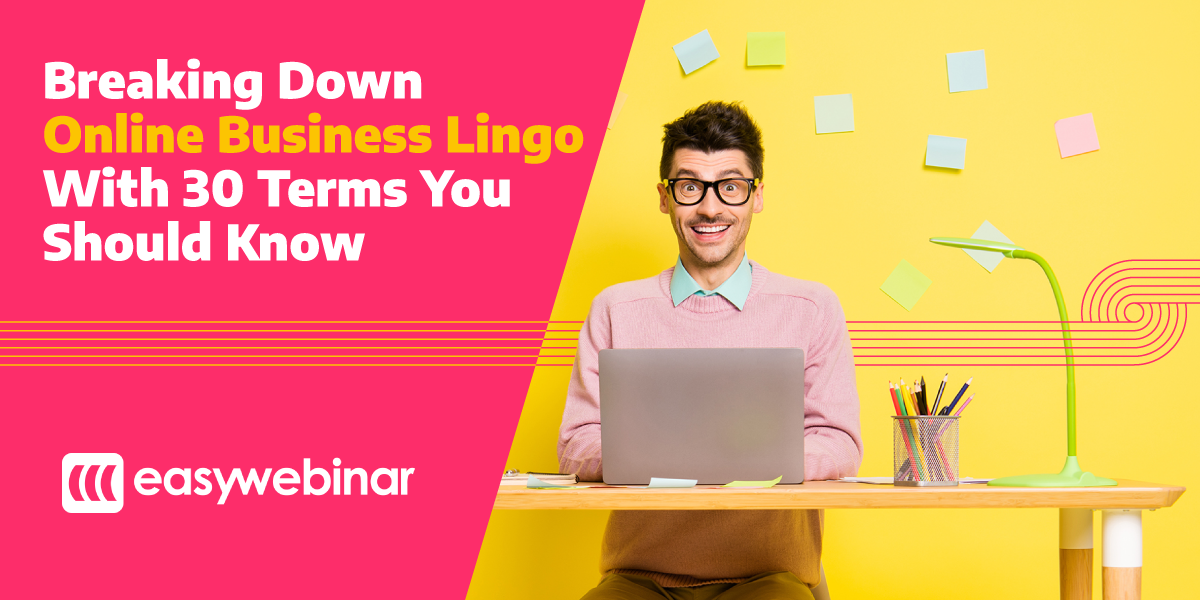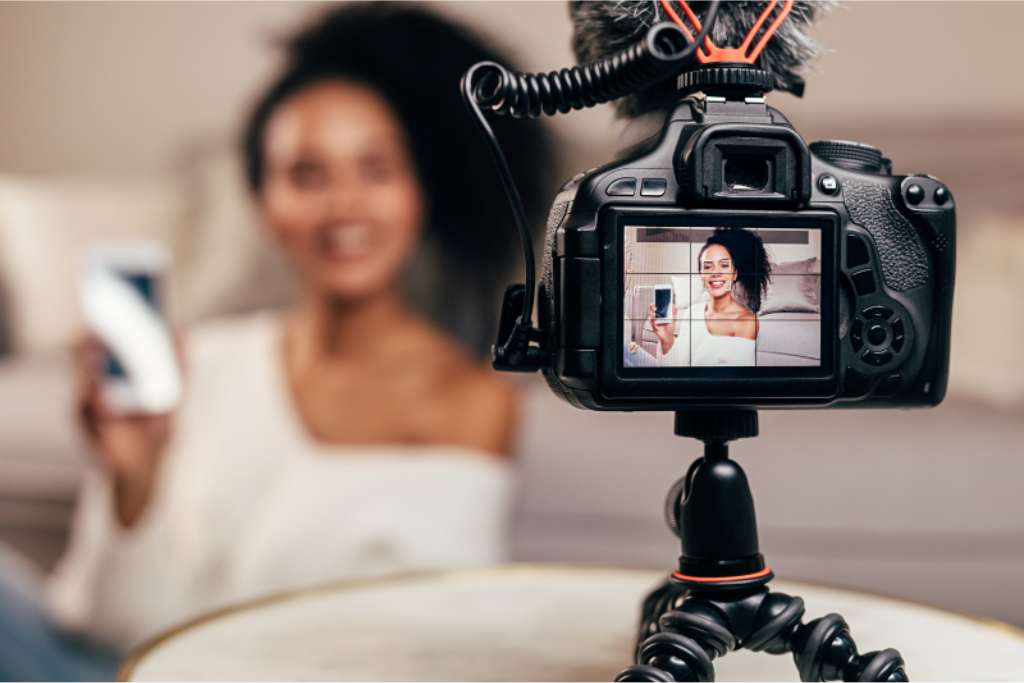30 Business Terms Every Online Entrepreneur Should Know

ICA, USP, CTA, KLT… OMG. So many acronyms, so little time. When you start off in the online business space, it can seem like everyone is speaking in code. Well, today, we have your key. Solely, FYI, we’ve put together a list of 30 business terms every online entrepreneur should know.
Consider this your online economy glossary; let’s get started!
Online Business Vocab Quick Guide
B2B
Business to Business. This is when a business serves the needs of other businesses. A few examples of online B2B companies are Teachable, Kajabi, and EasyWebinar. All of these businesses are helping other businesses by providing tools––in this case, easy-to-use platforms and software––to run their business.
Docusign is a B2B business that helps businesses secure eSignatures on contracts. James Wedmore’s “Business by Design” is a B2B company that helps online course creators run their online businesses more efficiently. Marie Forleo’s CopyCure is a B2B product that allows online businesses to better communicate with their ideal customer by improving their copywriting skills.
Even if you run your own business as a solopreneur, if you are addressing how your product or service enhances their business, you are probably talking B2B. However, if you are addressing how your company can help the business owner as a person (i.e., to get healthier, to nail their yoga arm balances, to transition to a gluten-free diet) your company is operating B2C.
B2C
Business to Consumer. This is a business that sells directly to consumers. They sell to the personal customer. For example, Melissa Wood Health (MWH) and The Sculpt Society (TSS) are both digital fitness membership programs that serve consumers directly. Their customers may be business owners, but MWH and TSS are serving the individual as a person, not as a business.
And sometimes businesses will do both, or they will grow to do both. For example, a content creator may start their business by monetizing their content and selling their own merchandise B2C––directly to the consumer. But as their success grows, they may start a mentorship program or create a course, teaching other content creators how to better run their content creation business. They may design email templates for content creators to use for building and monetizing their email list or pre-created content calendars to help them get more organized. This would be considered B2B, as they are teaching content creator business owners how to better run their actual business. They would also “speak to” the content creator business owner when creating their ICA and their USP.
Content
Content is anything you create and publish online for public consumption. This includes, but is not limited to, any text, audio, or video published on your website; social media posts; podcasts; YouTube videos; blogs; and/or newsletters.

Content Marketing
This is a form of attraction marketing where you “attract” leads by creating online content to stimulate interest, encourage engagement, entertain, or educate. Content marketing is an excellent way to build KLT, as the customer is getting to know you through the content you create. Then, as you release your products or services, they are more comfortable doing business with you.
Convert
When you turn a lead into a customer.
Copy
At its simplest, copy is the written content that you see on websites, ads, in books, in magazines, or on packaging, as opposed to the images or video present. Writers often write copy, but there is a difference between copywriting and content writing, which we cover next.
Copywriting
This is the “copy” that is used for the purpose of conversion. It’s writing with sales in mind. Though there are writers that can do both, there are definitely writers who specialize in writing for conversion, which is copywriting, and writers who specialize in writing for relationship building and engagement, which is the goal of content writing.
Generally speaking, a copywriter would write your sales pages, ad copy, and lead pages. A content writer would write your blog, newsletter, podcast, and social media posts.
CTA
Call To Action. A Call To Action is a request for your target to take action. An example of a Call To Action is a “Buy Now” button. Other CTA copy examples include “Subscribe Now,” “Download,” “Watch Video,” and “Listen Here.”
CTR
Click-Through Rate. The percentage of people who followed through on clicking on a link, once the option was presented.
For example, let’s say you are running a Facebook Ad campaign. Your ad is shown 100 times. Of the 100 times that ad is shown, someone clicks on the link to go to the actual website (sales page, lead page, product) 30 times. That means you have a 30% CTR. Thirty percent of the time, people are clicking the link to go to your website when they are given the option.
Email Newsletter
An email newsletter is a form of digital communication whereby your company sends an email update to a list of subscribers. This communication includes, but is not limited to, company news, tips, and updates. Though product drops and launches, sales notifications, and other sales-related communications are definitely a factor of company newsletters, think of your newsletter as an excellent place to build engagement and relationships first, before selling.
Evergreen
Evergreen is a term in the online space that means continually relevant or timeless content. In course creation terms, evergreen refers to courses that are sold all the time or year-round, as opposed to being launched “live” for a specific time and then “closed” until the next time the creator runs the program.
Fresh Content
Also known as content freshness, fresh content refers to content that has been recently published or updated. We have a deep-dive blog post on Think With Google that takes a closer look at content freshness. This is an excerpt:
“Google actually has a patent in relation to how it favors fresh content. But that doesn’t mean that all of your content has to be new. As a matter of fact, according to the Search Engine Journal, who ran their own test on the power of content freshness, the patent does state, ‘For some queries, older documents may be more favorable than newer ones.’
But if your content is more of the evergreen variety, chances are it’s not going to fall within that qualification. The good news is that you can repurpose older content, or ‘freshen it up.‘
This is done by going through your blog, updating the information, and republishing it.”
ICA
Ideal Customer Avatar (also called Ideal Customer or Customer Avatar). Your Ideal Customer Avatar is the personification of your target market. Your ICA is a single person who represents your most desired customer––your “ideal” customer.
Once you have this person in mind, you can speak directly to them with your content, marketing, and ads.
Keywords
Any term or word you type into a search engine is a keyword. For your business’s content, keywords are the words or phrases you would like your material to rank with when searched on Google.
For example, “webinar” or “what is a webinar” are keywords EasyWebinar may use in an article about why webinars are the best marketing tool. Then, someone looking to learn about webinars may type “what is a webinar” into Google, causing EasyWebinar’s article to appear on the SERP.
KLT
Know, Like, and Trust. This is a marketing concept that leans on the idea that people are more likely to purchase from a brand that they have a relationship with, or one that they know, like, and trust.
Because of this relationship, people are familiar with you. They’ve formed a connection with you. They view you favorably, and, most importantly, they believe in your integrity. With these things firmly in place, they are ready or even excited to do business with you.

Landing Page
These are strategic pages created to capture and convert the traffic that “lands” on the website. Landing pages have a single conversion focus––either to collect leads’ contact information or to encourage them to make a purchase.
Lead
A lead is someone who shows interest in your company’s product or service. In the online business world, this is often done by a person following a CTA and “opting-in” by giving the company their email address.
You would typically contact your lead after they have opted-in to hear from you. The goal is to eventually convert a lead.
Lead Magnet
Also called an “opt-in,” a lead magnet is a high-value “freebie” that people are gifted in exchange for their email address. This could be an ebook, video masterclass, audio teaching, coupon code, anything! Normally, it’s digital, and the customer receives it automatically after they’ve submitted their email address. Lead magnets are an excellent way to grow your list, and past/recorded and automated webinars are excellent lead magnet choices.
Live Online Course
A live online course is a digital program that has live elements, like Facebook Lives or live Zoom meetings, and is only offered at specific times of the year. A customer would not be able to purchase this course year-round. Usually, the course creator will “open the cart” to the live course for a specific amount of time, and then “close the cart” at the end of that time to focus on the enrolled students.

Monetizing
To monetize means to earn revenue (money) from. In the online space, this may mean earning revenue through your social media, email list, or any way that you are sharing content. There are many ways for an online business to monetize beyond selling its own products and services.
A few examples include: monetizing a YouTube channel via Adsense ads, sponsorships, memberships, and affiliate links; monetizing other social media accounts with sponsorships and affiliate links; monetizing an email list by acting as an affiliate for others’ programs and services; and monetizing a website with ads, sponsorships, and paid content.
Opt-in Page
This is any page asking for information, whether it’s the visitors’ email, phone number, or any other visitor data or information. Your opt-in page may market your lead magnet with the goal of converting traffic into newsletter subscribers.
Opting In
Opting-in is when a potential lead gives you consent to contact them about your business by giving you their contact information. In the online business space, that usually means their email address or phone number. A customer will “opt-in” to your newsletter by providing you with their email and consenting for you to contact them.
Organic Traffic
Organic traffic is unpaid traffic from people finding your site organically, often from ranking high on a SERP. Blogging regularly, podcasts, and optimized social media are great ways to receive organic traffic.
Paid Traffic
Paid traffic is website traffic derived from paid advertisements.
ROI
Return On Investment. This is a performance measure used to evaluate the success of your marketing effort. It’s how much money you made taking into consideration how much money you spent. Some business owners will also include “time spent” in the measurement. Though there are different ways a business may choose to track ROI, here is a general overview of how it can work.
Let’s say that you are a yoga instructor with a $250 evergreen course teaching postpartum women how to rebuild and strengthen their pelvic floor.
If you spent $1000 on Facebook Ads and made $2500 in course sales, your investment in Facebook ads would have a positive ROI for your business.
But let’s say you don’t have a $1000 marketing budget. You do have two hours of time to devote to marketing a day, though, so you choose to try out video content. For two months you put your content on TikTok, YouTube, and IGTV, with specific landing pages to track sales of your course from each. Let’s also assume you have 100 subscribers/followers on each account.
IGTV traffic brings in $250 (sells 1 course). TikTok traffic brings in $2500 (sells 10 courses). And YouTube traffic brings in $750 (sells 3 courses).
Of your social media accounts, TikTok would have the highest ROI.
SEO
Search Engine Optimization, or SEO, is improving your website’s visibility by maximizing its location (specifically, how high it appears) on the Search Engine Results Page (SERP) to increase organic traffic to your website.
Basically, the goal of SEO is getting your website to show up as close to the top of a Google search as possible.

SERP
Search Engine Results Page. This is the results page you see after searching for a term online.
Squeeze Page
A squeeze page is a landing page that has no navigation or additional CTA that could potentially distract the visitor. Their only option is to either follow the single CTA or close the page.
USP
Unique Selling Proposition. This is that “special sauce” that makes your brand distinct. It’s the unique characteristic that differentiates you from your competitors. What, specifically, makes your business, product, or service stand out from the crowd? That’s your USP.
Webinar
Full disclosure: We are a webinar company. Of course, we’re going to include this method of marketing in our terms you should know. But, bias aside, webinars remain one of the top ways to gather leads and convert those leads into customers.
A webinar is a live or automated online presentation used to educate an audience on a particular subject. You may have also heard them called a masterclass, online training, or online seminar. Participants may ask questions, make comments, and respond to polls, with the teacher engaging with their participants in real-time. This robust form of engagement, where both participant and presenter share and receive information, is one of the many reasons live webinars are so effective.

There you have it! 30 business terms every online entrepreneur should know.
Ready to take your business to the next level? Begin to build brand authority through webinars. Sign up for EasyWebinar, and gain access to the most effective form of marketing, for free, today.
This post was authored by Arynetta Northcutt. Arynetta is a solopreneur, content creator, and EasyWebinar contributor.
